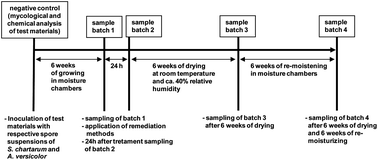We compared the efficiency of some commercially available products and methods used for remediation of mould-contaminated building materials. Samples of gypsum board and pinewood were artificially contaminated with toxin-producing isolates of Stachybotrys chartarum and Aspergillus versicolor, respectively, then, ten different remediation treatments were applied according to the manufacturers' instructions. Microbial and chemical analyses of the infested materials were carried out both immediately before and after treatment, after six weeks of drying at room temperature, and after another six weeks of remoistening. The aim of the study was to determine whether the investigated methods could inhibit the mould growth and destroy some selected mycotoxins produced by the moulds. None of the decontamination methods tested could completely eliminate viable moulds. Some methods, especially boron based chemicals, ammonium based chemicals, and oxidation reduced the contents of mycotoxins produced by S. chartarum (satratoxin G and H, verrucarol), whereas the one which uses an ammonium based chemical reduced the amount of sterigmatocystin produced by A. versicolor with statistical significance. No remediation treatment eliminated all the toxins from the damaged materials. These results emphasize the importance to work preventively with moisture safety throughout the construction processes and management to prevent mould growth on building materials.

You have access to this article
 Please wait while we load your content...
Something went wrong. Try again?
Please wait while we load your content...
Something went wrong. Try again?


 Please wait while we load your content...
Please wait while we load your content...